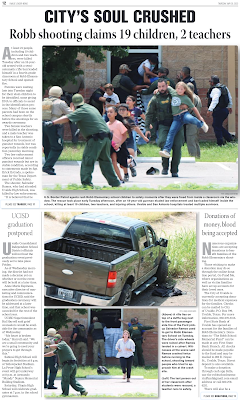A journalism professor who is researching alternative business models for community newspapers, and is about to test one of them at a paper in Kansas, will be a major presenter at the National Summit on Journalism in Rural America, to be televised on
YouTube June 3 and 4.
 |
| Dr. Teri Finneman |
Teri Finneman, an associate professor at the
University of Kansas, is among 20 journalism professionals on the program for the summit. Most are practitioners, some are academics, and some are both; Finneman is
publisher of the Eudora Times with her journalism students.
Other speakers at the summit, to be held at the
Shaker Village of Pleasant Hill in Kentucky, include Penny Abernathy of
Northwestern University, Jason Alcorn of the
American Journalism Project, Jonathan Kealing of the
Institute for Nonoprofit News, publishers Terry Williams of the
Keene (N.H.)
Sentinel, Dennis Brack of the
Rappahannock News in Virginia, Bill Horner of the
Chatham (N.C.)
News+Record, Marshall Helmberger of the
Timberjay in Tower, Minn., Jody Lawrence-Turner of the
Fund for Oregon Rural Journalism and Elizabeth Hansen Shapiro of
Columbia University, co-founder of the
National Trust for Local News. It will be livestreamed at
https://ukci.me/ruralj starting at 1:15 p.m. Friday, June 3.
The summit is being held by the University of Kentucky's Institute for Rural Journalism and Community Issues. Its director, Al Cross, said "Penny Abernathy and Teri Finneman were the first two academics we invited to be part of this event, which seeks to answer the question: How do rural communities sustain local journalism that supports local democracy? We think the answer must come not just from practitioners and academic, but from communities."
Finneman has examined possible new business models for community papers, and this summer will test one that "moves away from heavy reliance on advertising and cheap subscriptions," says
a KU news release. "If the new model is successful in use of memberships, e-newsletters, events and new content direction, plans call to distribute a new model available for rural weeklies across the country." The research is funded by KU's
William Allen White School of Journalism & Mass Communications, the
Southern Newspaper Publishers Association Foundation and the state newspaper associations of Kansas, Nebraska and the Dakotas.
Publishers might be surprised to hear that 40 percent of small-town newspaper readers in a Great Plains survey by Finneman and her research partners (Pat Ferrucci of the
University of Colorado and Nick Mathews of the
University of Missouri) said they would be very likely or likely to donate, in addition to subscription costs, to support their local paper.
“There’s a tremendous disconnect between what readers say they are willing to support and what publishers are willing to consider,” Finneman said. “This business model we’re testing is all about being proactive if the day comes when newspapers lose another revenue source in legal notices, having a safety net in place and evolving.”
Publishers were presented with 15 potential revenue streams and asked which they would be willing to try. They were most receptive to the traditional sources of advertising, subscriptions and legal notices from governments. The least popular options were memberships, e-newsletters, direct government support and large private donations. But among the 400-plus readers surveyed, memberships and e-newsletters were among the most popular responses.
The model developed by Finneman, Ferrucci and Mathews includes memberships in which readers can get different levels of benefits. "The model will also work to engage community members, especially young residents, and focus on preferred reader content," the news release says.
The model will be tested at
Joey Young's
Kansas Publishing Ventures, which has
Harvey County Now in Newton and the
Hillsboro Free Press and will get $10,000 to participate in the experiment. “Just knowing Joey and the team there, there’s a lot of enthusiasm, there’s a passion for journalism and there’s a willingness to try, that isn’t there with many other places,” Finneman told Harvey County Now.
The newspaper's story said, "Harvey County Now hopes its participation in the project will present findings that can help other news organizations build strong and sustainable local newsrooms and enjoy some of the success the publication has had."















